
You've probably heard the buzz about a potential $5,000 payment from something called "DOGE" that might land in Americans' bank accounts. These rumors began circulating after President Donald Trump mentioned the possibility during a summit in Miami Beach earlier this year.
With many households still feeling financial pressure from inflation and rising costs, the prospect of an unexpected $5,000 check understandably captures attention.
But before you start planning how to spend this money, it's vital to separate fact from speculation and how likely it will happen.
» Need help with tax debt? Explore our best tax relief services for 2025.
Key Insights
- The $5,000 DOGE stimulus check is a speculative proposal, not an actual forthcoming payment.
- DOGE is a temporary cost-saving organization, not a federal agency authorized to issue payments.
- The proposed DOGE dividend targets different recipients and has different goals than previous stimuli.
- Multiple complex steps would be required before any potential DOGE payment could become reality.

What Exactly Is DOGE?
DOGE stands for the Department of Government Efficiency, a temporary organization created by the Trump administration. It's not a traditional government agency but rather an initiative led by Elon Musk as a "special government employee."
The organization's stated mission is threefold:
Cut federal spending
Reduce government regulations
Modernize federal technology and software
Unlike NASA, the Department of Defense, or other permanent federal departments, DOGE is a temporary structure designed to identify cost-saving opportunities across the federal government. It doesn't have the authority to issue payments directly to Americans—that power remains with Congress.
The Origin of the DOGE Stimulus Check Idea
The concept of a "DOGE dividend" came from investment firm CEO James Fishback, who outlined a four-page proposal suggesting that savings generated by DOGE's efficiency efforts could be partially returned to taxpayers.
President Trump referenced this idea during an unscripted moment at the Saudi-sponsored FII PRIORITY Summit, where he said they’re considering giving 20% of DOGE savings to American citizens and 20% to paying down government debt.
This casual mention—not an official policy announcement—sparked widespread speculation about a potential $5,000 payment. The figure appears to be based on projected savings that DOGE might generate.
Could You Actually Receive a DOGE Check?
There's currently no legislation or official plan to distribute DOGE stimulus checks. Several critical factors make this proposal different from previous stimulus payments:
Congressional approval required: Any federal payment to Americans would need to be approved by Congress through legislation. As of now, no such bill has been introduced.
Limited eligibility proposed: Unlike pandemic-era stimulus checks that went to most Americans, Fishback's proposal mentions explicitly that payments would go only to "tax-paying households" above a certain income level (basically, only to people who have paid taxes).
Contingent on actual savings: The proposal ties any potential payments to money actually saved through DOGE's efficiency efforts—savings that would need to be verified and realized before a distribution could occur.
Different economic purposes: Previous stimulus checks were designed to boost economic activity during a crisis. The DOGE dividend concept is positioned more as a "refund" paid for by government savings.
» Looking to reduce your tax burden? Learn proven strategies to pay less taxes.
How Would This Differ from Recent Stimulus Payments?
It's important to distinguish this potential DOGE payment from recent stimulus checks that some Americans received in late 2024 and early 2025.
Those payments—up to $1,400 per eligible person—were authorized under the Biden administration and distributed by the IRS. They represented Recovery Rebate Credits for taxpayers who hadn't claimed them on their 2021 tax returns but were eligible for pandemic-era stimulus funds.
These recent payments were:
Based on established legislation
Funded by previously allocated government funds
Distributed through existing IRS mechanisms
Available to taxpayers who file their 2021 tax return by April 15, 2025
The proposed DOGE payments would fundamentally differ in funding source, eligibility, and purpose.
Who Would Qualify Under the Current Proposal?
While no official eligibility requirements exist (since there's no actual program yet), Fishback's proposal outlines a significant departure from previous stimulus programs:
Only "net payers of federal income tax" would receive payments.
Households below certain income thresholds might be excluded.
The focus would be on taxpayers with "a lower propensity to spend and a higher propensity to save."
This approach contrasts sharply with pandemic stimulus checks, which were designed to help lower-income households and stimulate immediate spending.
According to Fishback, previous stimulus efforts sent payments "indiscriminately" and provided some low-income households with "transfer payments of 25 to 30% of their annual income."
The Economic Rationale and Criticism
Proponents of the DOGE dividend idea argue it would be fundamentally different from previous stimulus programs because:
It would be funded by actual government savings rather than deficit spending.
It would reward taxpayers for government efficiency.
It theoretically wouldn't contribute to inflation because the funds would come from government savings rather than printed dollars.
It would generate new investments since recipients would be more likely to save rather than spend the funds.
Critics, however, point out several potential issues:
The savings to fund such payments may not exist yet.
Excluding lower-income households raises equity concerns.
The proposal assumes DOGE will generate enormous savings, which still needs to be proven.
The actual distribution mechanism is undefined.
What Should You Expect Next?
If you're wondering whether to adjust your financial plans in anticipation of a DOGE check, here's the bottom line: Don't count on receiving this money anytime soon.
For a DOGE dividend to become a reality, several things would need to happen:
DOGE would need to identify and implement significant cost-cutting measures
These savings would need to be verified and quantified
The administration would need to develop a formal proposal
Congress would need to draft and pass legislation authorizing the payments
A distribution system would need to be established
Each step would take considerable time, and there's no guarantee it'll happen. The concept remains just that—a concept mentioned in passing without detailed planning or legislative momentum.
Conclusion
While the idea of receiving a $5,000 government check is appealing, the DOGE dividend remains a speculative proposal without any concrete implementation plan. Unlike previous stimulus payments with clear legislative authority and funding, this concept is still in its earliest theoretical stages.
Your best approach is to maintain your current financial planning without factoring in this potential payment. If the proposal gains serious traction in Congress, you'll have time to learn about eligibility requirements and timelines before any distribution occurs.
In the meantime, if you're struggling with existing tax obligations, consulting with recommended tax relief services can provide more immediate financial assistance than waiting for speculative government payments.
» Dealing with IRS problems? Discover how to settle tax debt by yourself.



